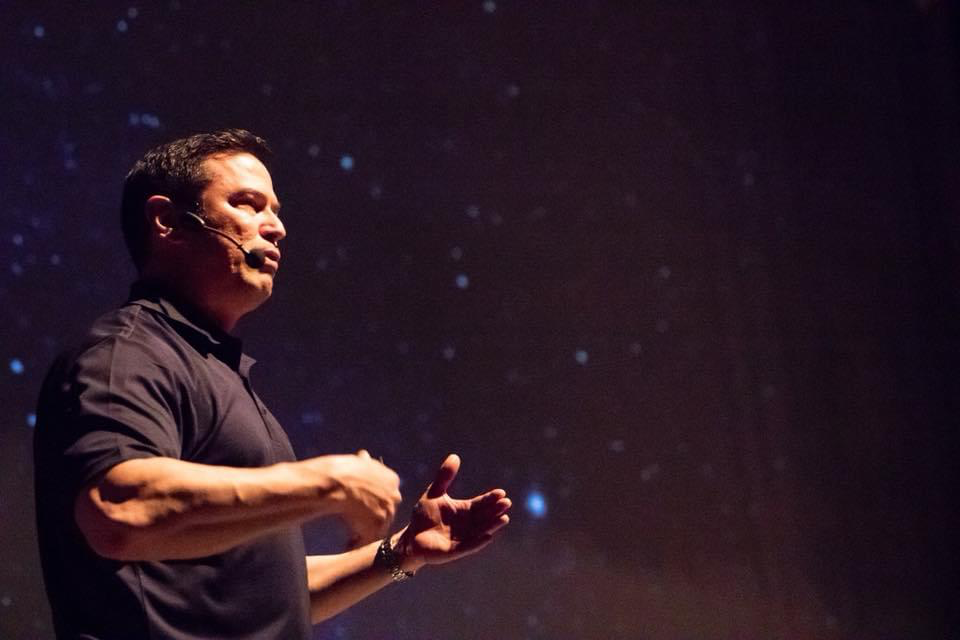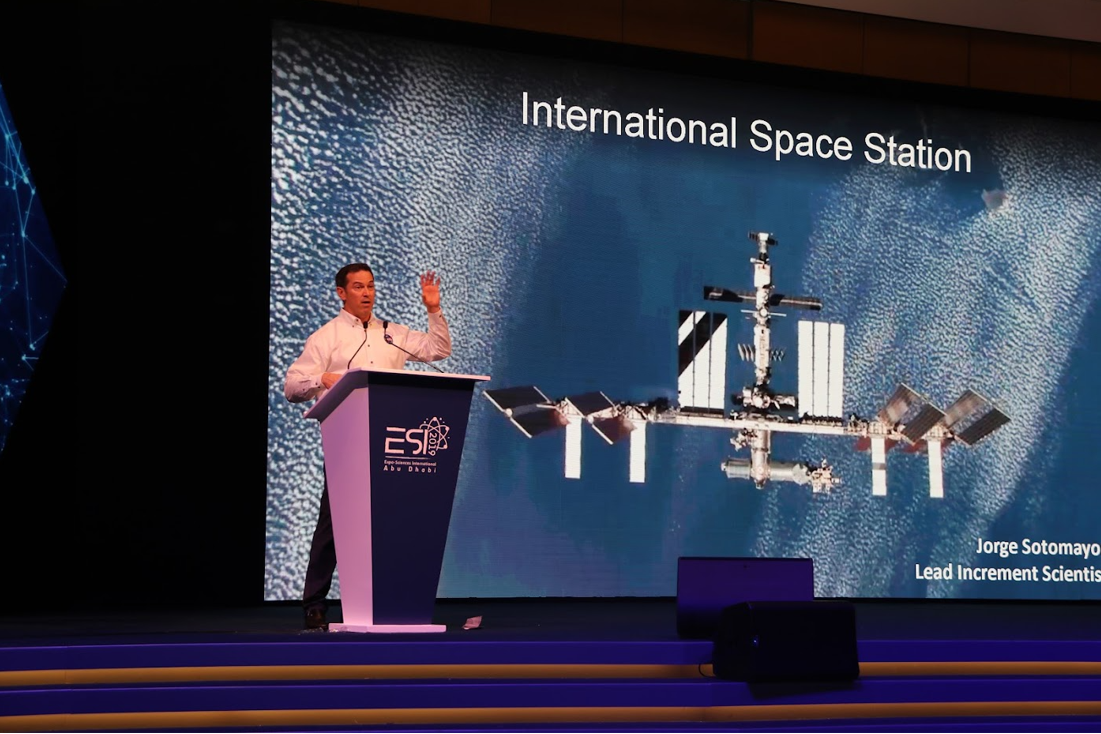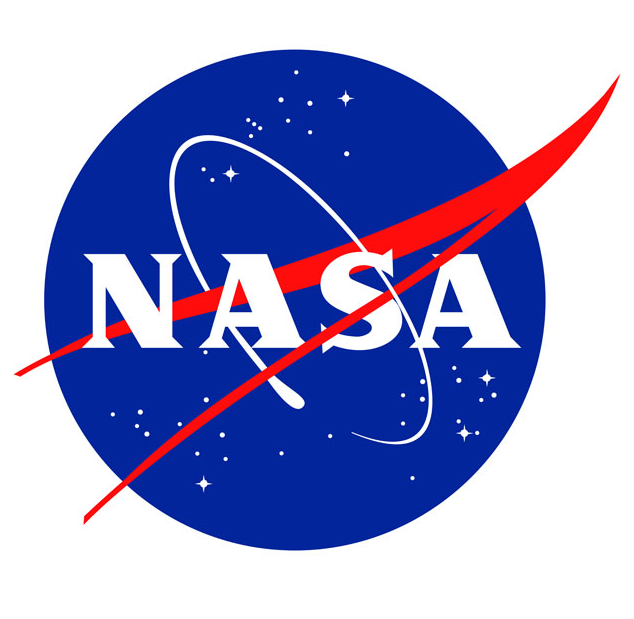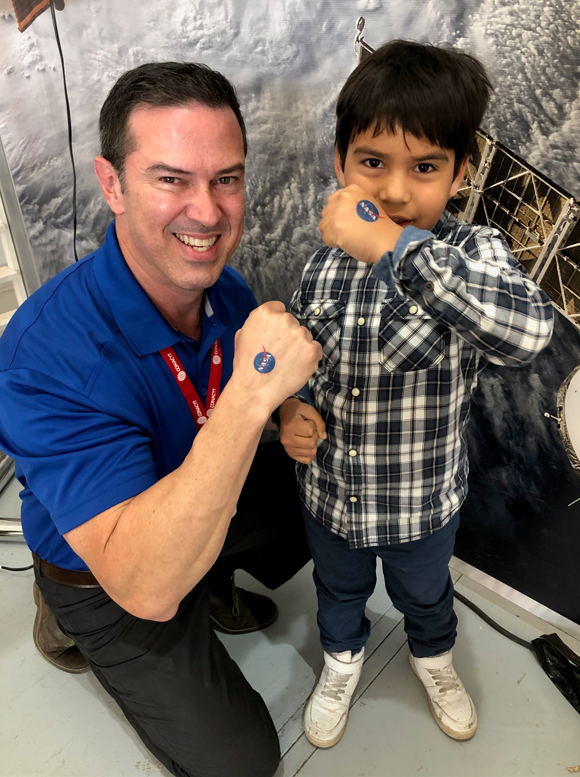Station Nation: Meet Jorge Sotomayor, Research Portfolio Manager Leading the STEM Client Sphere within the Research Integration Office
Jorge Sotomayor, research portfolio manager leading the STEM Client Sphere within the Research Integration Office, as a kid fell asleep watching the stars, wondering about space exploration. Pursuing his love of space and science led to a role at NASA, where he helps launch science experiments to the space station. Sotomayor shares his love for delicious traditional Puerto Rican holiday foods in honor of Hispanic Heritage Month (and a few workout tips to stay balanced), his preference for worm or meatball logo, and his passion for sharing science on station with the next generation of explorers and problem-solvers. Read on to learn more!
Where are you from?
I was born and raised in the tropical mountains of Puerto Rico. I studied in my hometown through 10th grade, and when I was 15 years old, went to a school for geeks to consolidate the junior and senior years into one. This gave me an early start to college life. As a little kid in Puerto Rico, I remember falling asleep watching the stars through my window and wondering what life would be like on another planet, thinking about traveling to the stars and exploring new worlds.

Tell us about your role at NASA.
I currently work as a research portfolio manager, leading the STEM Client Sphere within the Research Integration Office (OZ). Before that, I worked as a lead increment scientist, coordinating science implementation during real-time operations.
My responsibilities include helping scientists from academia, private industry, government institutions, and from various nations to get their experiments ready so they can fly to the International Space Station.

Sotomayor was the keynote speaker at the Expo Sciences Latin America 2018, or ESI AMLAT 2018, in Chile, where he provided space station research highlights to an audience of 800 K-12 students and educators from 10 Latin American countries. Image courtesy of Jorge Sotomayor.
How would you describe your job to family or friends that may not be as familiar with NASA as employees reading this?
I send experiments to the space station so that astronauts living onboard can run experiments for scientists on the ground.
How long have you been working for the agency?
I’ve been working at NASA for 33 years.
What was your path to NASA?
I have always been fascinated by space. My initial interest in college was to study astronomy, but after talking with some of my physics and astronomy professors, I decided to study theoretical physics instead, as it would allow more flexibility in the job market. As hard as it may be for a physicist to find a job, it’s even harder for an astronomer! So, I completed my bachelor’s and master’s degrees in physics, which allowed me to find job at NASA in fields of aeronautics and space.
I started my NASA career at Glenn Research Center in Cleveland, Ohio, where I worked for 10 years in aeronautics. I transferred to Johnson Space Center in June 1998 to work as part of the International Space Station (ISS) program in Houston, just five months before the launch of the first station module, Zarya.
Is there someone in the space, aerospace, or science industry that motivated you or inspired you to work for the space program? Or, someone you discovered while working for NASA who inspires you?
During one of my rotations as a lead increment scientist in 2017, I had the opportunity to work with Dr. Peggy Whitson, who was a crew member on station at the time. By the end of her mission in September 2017, Peggy had accrued a total of 665 days in space over the course of her career, making her NASA’s most experienced astronaut to date. For sure, she kept us busy on the ground, as she continuously asked for more science to do on orbit. And the more science we gave her, the more she wanted! Her dedication, love of science, and her incredible work ethic was an inspiration not only to me, but to the entire ground team, the on-orbit crew, and those who worked with her.
But working at NASA provides an extensive amount of role models and inspiration. I remember when Bill Gerstenmaier was the ISS program manager, he was very transparent and communicated his strategy very clearly to gain the team’s buy-in. His simplicity and honesty were qualities that permeated across the ISS program team. He was a visionary who would not only see where the ISS program had to go in the near future, but he also knew how to prepare the agency in the long run for long-term space exploration missions. His influence is still felt today. These and many other characteristics led Bill to his role as NASA’s associate administrator for human exploration and operations for 14 years.
Can you tell us more about your Puerto Rican heritage? Any special traditions?
I’m originally from Puerto Rico. My maternal grandparents migrated to Puerto Rico from the Canary Islands and Galicia (in Spain) when they were small children. My family on my father’s side has been living in Puerto Rico for several generations. Since late 15th century, Puerto Rico has seen interactions between the Tainos (the indigenous people of the island) and the Spanish settlers. Puerto Rican culture today is a blend of Taino, Spanish, and African cultures. Traditional food is at its best during the Christmas holidays, with delicious dishes like “lechón asado” (whole pig roast), “arroz con gandules” (rice with pigeon peas), “pasteles” (type of tamale made with pork/chicken and adobo stuffing encased in a green plantain masa and wrapped in banana leaves), “tostones” (crispy fried plantains), and many more. If you’re not careful, you can easily gain five to 10 pounds during a trip to Puerto Rico during the holidays!
What is your favorite NASA memory?
Watching a shuttle launch from Kennedy Space Center’s Launch Control Center.
What do you love sharing about station? What’s important to get across to general audiences to help them understand the benefits to life on Earth?
I love talking to students about NASA and the great science being done aboard the space station. These experiments and demonstrations are paving the way to expand human space exploration and establish a permanent human presence beyond low-Earth orbit. For example, we are learning how to grow vegetables in space — a critical capability for future human settlements on the Moon and Mars (and beyond). The technology and knowledge used to create optimal conditions for plants to grow in space can also support plant growth in harsh environments on Earth.
But there are tons of cool experiments going on at the station at any given time. Robotic technology development is another area I like to share with general audiences. Multiple robotic technologies have been tested on the station, including Robonaut, a humanoid robot that can assist humans explore in space. As the technology matures, machines like Robonaut will someday assist astronauts side by side on exploration missions, perform spacewalks for the astronauts, and explore dangerous places on Earth and in space for humans.
 Sotomayor provided closing remarks at MILSET’s Expo Sciences 2019 in Abu Dhabi, United Arab Emirates. He highlighted station research and NASA’s exploration objectives to more than 2,000 middle and high school students and educators from 50 countries worldwide. Image courtesy of Jorge Sotomayor.
Sotomayor provided closing remarks at MILSET’s Expo Sciences 2019 in Abu Dhabi, United Arab Emirates. He highlighted station research and NASA’s exploration objectives to more than 2,000 middle and high school students and educators from 50 countries worldwide. Image courtesy of Jorge Sotomayor.
I also like to show investigations performed aboard the station that were designed by students, just like the students present in the audience. They are the future scientists and space explorers, the future problem solvers who will come up with new, innovative ideas to solve problems on Earth and take us to the next phases of space exploration. One thing I want them to realize is that the future doesn’t start when they graduate from high school or college, or when they get a job. Their future starts right there and then, and the decisions they make today will shape what their future will look like tomorrow. When I talk to an audience, if I can touch the heart of just one person or student, I consider that mission accomplished!

What are your hobbies/things you enjoy outside of work?
I enjoy exercising, mostly resistance training (i.e., lifting weights). Will do some cardio as well, although I must admit it is not my favorite type of exercise! To make the most out of cardio in the least amount of time, I do High-Intensity Interval Training, or HIIT, cardio for 10 minutes three times a week and call it a day. I also enjoy working in my yard and designing landscaping projects. Currently, I’m almost done landscaping the house my wife and I moved into a couple of months ago.
Day launch or night launch?
Anytime launch!
Favorite Space Movie?
My favorite sci-fi, space-related movie is “Avatar” because it shows one possibility of what an extraterrestrial world could look like. I also like “The Martian” and how it explores the difficulties of living on another planet (and how to grow potatoes on Mars 😊).
NASA Worm or Meatball logo?
Every day, we’re conducting exciting research aboard our orbiting laboratory that will help us explore father into space and bring benefits back to people on Earth. You can keep up with the latest news, videos, and images about space station science on the Station Research and Technology news page. It’s a curated hub of ISS research digital media from JSC, other centers, and space agencies.
Sign up for our once-a-week email newsletter to get the updates delivered directly to you.
Follow updates on social media at @ISS_Research on Twitter, and on the space station accounts on Facebook and Instagram.








